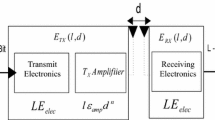Abstract
With the growth of different design goals and application requirements, wireless sensor networks (WSNs) have been increasingly popular for a wide variety of purposes, e.g., image formation of a target field, intrusion detection, surveillance and environmental monitoring. In this paper, a multi-hop heterogeneous cluster-based optimization algorithm (MHCOA) for WSNs is proposed. The motivation to MHCOA for WSNs is that several higher energy sensor nodes act as cluster heads, which are deployed artificially, while some low energy sensor nodes act as cluster members, which are deployed randomly. In order to realize monitoring task, we complete three major works in this paper. First, MHCOA calculates the number of cluster heads and communication radius of low energy sensor nodes; Second, it finishes monitoring task through data packets transmission with higher energy nodes acting as cluster heads in the form of multi-hop heterogeneous WSNs; Finally, simulation results show that compared to its peers in heterogeneous WSNs, MHCOA reduces the number of cluster heads, which saves the network average energy by up to 16.7 % and extends the network life by up to 38 %, while with less end-to-end delay.







Similar content being viewed by others
References
Mhatre, V., Rosenberg, C. (2004). Homogeneous vs heterogeneous clustered sensor networks: A comparative study. In 2004 IEEE International Conference on Communications (ICC’04), Paris, France, Jane, 2004, vol. 6, pp. 3646–3651.
Antonio, P., Grimaccia, F., & Mussetta, M. (2012). Architecture and methods for innovative heterogeneous wireless sensor network applications. Remote Sensing, 2012(4), 1146–1161.
Kumar, D., Aseri, T. C., & Patel, R. B. (2009). EEHC: Energy efficient heterogeneous clustered scheme for wireless sensor networks. Computer Communications, 32(4), 662–667.
Han, L. I. (2010). LEACH-HPR: An energy efficient routing algorithm for heterogeneous WSN. In IEEE International Conference on Intelligent Computing and Intelligent Systems (ICIS2010), vol. 2, pp. 507–511.
Heinzelman, W., Chandrakasan, A., & Balakrishnan, H. (2002). An application-specific protocol architecture for wireless micro sensor networks. IEEE Transactions on Wireless Communications, 1(4), 660–670.
Manjeshwar, A., Grawal, D. P. (2001). TEEN: A protocol for enhanced efficiency in wireless sensor networks. In Proceedings of the 15th Parallel and Distributed Processing Symposium (pp. 2009–2015). San Francisco: IEEE Computer Society.
Younis, O., & Fahmy, S. (2004). HEED: A hybrid, energy-efficient, distributed clustering approach for ad-hoc sensor networks. IEEE Transactions On Mobile Computing, 3(4), 660–669.
Qing, L., Zhu, Q., & Wang, M. (2006). Design of a distributed energy efficient clustering algorithm for heterogeneous wireless sensor networks. Computer Communications, 29(12), 2230–2237.
Duan, C. & Fan, H. (2007). A distributed energy balance clustering protocol for heterogeneous wireless sensor networks, wireless communications, networking and mobile computing. In WiCom 2007 International Conference, pp. 2469–2473.
Elbhiri, B., Saadane, R., & Aboutajdine, D. (2011). Stochastic and equitable distributed energy-efficient clustering (SEDEEC) for heterogeneous wireless sensor networks. International Journal of Ad Hoc and Ubiquitous Computing, 7(1), 4–11.
Zois, D. S., Levorato, M., & Mitra, U. (2013). Energy-efficient, heterogeneous sensor selection for physical activity detection in wireless body area networks. IEEE Transaction on Signal Processing, 61(7), 1581–1594.
Lu, X., Chen, X., Li, Y., et al. (2013). ZebraBAN: A heterogeneous high-performance energy efficient wireless body sensor network. IET Wireless Sensor Systems, 3(4), 247–254.
Akbas, M. I., & Turgut, D. (2013). Lightweight routing with dynamic interests in wireless sensor and actor networks. Ad Hoc Networks, 2013(11), 2313–2328.
Rappaport, T. (2002). Wireless communication principles and practice (2 (M) ed.). Upper Saddle River, NJ, London: Prentice Hall PTR.
Mhatre, V., & Rosenberg, C. (2004). Design guidelines for wireless sensor networks: Communication, clustering and aggregation. Ad Hoc Networks, 2(1), 45–63.
Acknowledgments
The material presented in this paper is based upon work funded by National Natural Science Foundation of China (60873003, 60873195); Ph.D. Programs Foundation of the Ministry of Education of China (20100111110004).
Author information
Authors and Affiliations
Corresponding author
Rights and permissions
About this article
Cite this article
Hu, S., Han, J., Wei, X. et al. A multi-hop heterogeneous cluster-based optimization algorithm for wireless sensor networks. Wireless Netw 21, 57–65 (2015). https://doi.org/10.1007/s11276-014-0769-z
Published:
Issue Date:
DOI: https://doi.org/10.1007/s11276-014-0769-z




